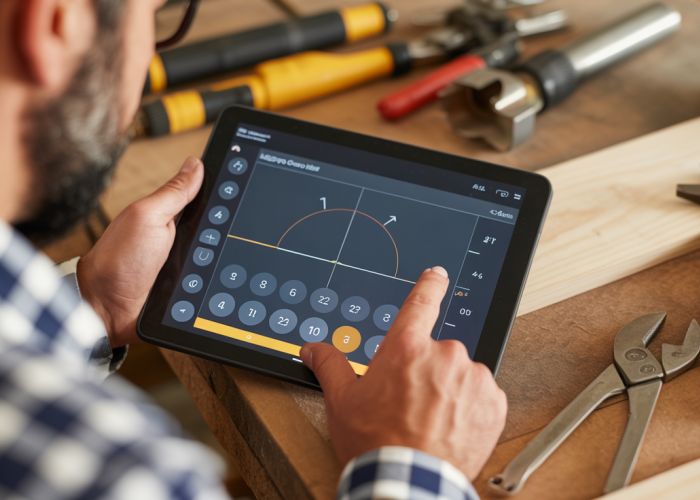Mastering DIY projects just got easier! The angle cut calculator, a handy tool for any woodworker, ensures precise measurements for perfect cuts. Miter saws, frequently used with an angle cut calculator, allow for angled cuts in materials. For example, Home Depot provides various angle cut calculators for calculating wood work and tools necessary for DIY projects. Using online resources provided by sites such as Instructables, DIY enthusiasts can find plans that often rely on accurate angle calculations, easily obtained with a reliable angle cut calculator.

Crafting the Perfect "Angle Cut Calculator: DIY Like a Pro" Article Layout
Let’s break down how to create an engaging and helpful article about using an angle cut calculator for DIY projects. We want it to be easy to follow and make our readers feel confident in their abilities.
1. Introduction: Hooking the Reader
- Start with a Problem: Briefly introduce a common DIY scenario where angle cuts are crucial (e.g., building a picture frame, installing crown molding, framing a window). Highlight the frustration of inaccurate cuts.
- Introduce the Solution (Angle Cut Calculator): Immediately present the angle cut calculator as a tool to overcome this challenge. Frame it as a user-friendly solution that removes the guesswork.
- Promise of "DIY Like a Pro": Emphasize that using the calculator empowers even beginners to achieve professional-looking results.
- Briefly outline the steps: Tease what readers will learn.
- Include the main keyword: Naturally embed "angle cut calculator" within the first paragraph.
2. Understanding Angle Cuts: The Basics
- Keep it Simple: Avoid technical jargon. Explain what angle cuts are in plain language.
- Types of Angles (Brief Overview):
- Miter angles
- Bevel angles
- Compound angles (mention these exist, but save detailed explanation for later)
- Why Accurate Cuts Matter: Underscore the importance of precision for a good fit and aesthetically pleasing results.
3. Introducing the Angle Cut Calculator
- What it Does: Clearly explain the function of the calculator – it determines the correct angle settings for your saw.
- Types of Calculators:
- Online Calculators: Mention the convenience and accessibility of web-based calculators.
- Smartphone Apps: Note the option of using dedicated apps on mobile devices.
- Built-in Saw Calculators: Briefly mention that some saws have integrated angle calculators.
- Key Inputs (Explain what data is needed):
- Angle of the corner or miter.
- Number of sides (if applicable).
- Material Thickness (for compound angles).
4. Step-by-Step Guide: Using an Angle Cut Calculator
- Finding a Reputable Calculator: Suggest trusted online calculators or apps. Offer tips for identifying a reliable source.
- Entering Your Measurements: Provide clear instructions on how to accurately input the necessary data into the calculator. Consider screenshots to illustrate this process.
- Interpreting the Results:
- Explain what the calculator displays (miter angle, bevel angle).
- Provide guidance on how to understand and apply these values to your saw.
- Example Scenario: Walk through a specific example.
- Scenario: Cutting trim for a 90-degree corner.
- Inputs: Corner Angle = 90 degrees, Number of Sides = 2
- Calculator Output: Miter Angle = 45 degrees
- Explanation: Set your saw to 45 degrees for each piece of trim.
5. Advanced Angle Cuts (Optional):
- Compound Angle Cuts: Explain what they are (a combination of miter and bevel cuts).
- When are these necessary: Baseboards, crown molding, etc.
- How to use the calculator for compound cuts: Explain the additional inputs (like spring angle) that might be required.
- Dealing with Imperfect Corners:
- Explain that not all corners are perfectly 90 degrees.
- Suggest ways to measure the actual angle and adjust the calculator accordingly.
-
Creating a table to illustrate different number of sides for inside and outside angles
Number of Sides Angle Inside Angle Formula Outside Angle Formula 3 60° (180-Angle)/2 (Angle+180)/2 4 45° (180-Angle)/2 (Angle+180)/2 5 36° (180-Angle)/2 (Angle+180)/2 6 30° (180-Angle)/2 (Angle+180)/2 8 22.5° (180-Angle)/2 (Angle+180)/2
6. Tips and Tricks for Accuracy
- Double-Check Your Measurements: Emphasize the importance of accurate measurements.
- Practice on Scrap Wood: Encourage practicing before cutting your final pieces.
- Use a Protractor or Angle Finder: Suggest using tools to verify the calculator’s results.
- Consider the Kerf: Explain the width of the saw blade and how it can affect accuracy. Suggest adding a slight kerf offset to the measurement.
- Calibrate your Saw: Mention importance of making sure your saw is correctly calibrated.
Angle Cut Calculator: FAQs
These frequently asked questions will help you better understand how to use an angle cut calculator for your DIY projects.
Why should I use an angle cut calculator instead of guessing?
Using an angle cut calculator ensures accuracy. Guessing can lead to misaligned joints, wasted materials, and a less professional finished product. The calculator takes the guesswork out of determining the precise angles needed.
What kind of information do I need to use an angle cut calculator?
Typically, you’ll need to know the desired final angle and the number of sides your project will have. Some angle cut calculators also require information about miter and bevel angles.
Can an angle cut calculator help with compound miter cuts?
Yes! Some angle cut calculators are specifically designed to calculate compound miter angles, which are required when cutting angles on two different planes simultaneously. These calculations are complex, so an angle cut calculator is essential for accuracy.
Are angle cut calculators only for woodworking?
No, while commonly used in woodworking, an angle cut calculator can be applied to any project that requires precise angle cuts, such as metalworking, tiling, or crafting. Anytime you need to join pieces at a specific angle, this tool can be beneficial.
So, there you have it! Now you’re armed with the knowledge to use an angle cut calculator like a total pro. Go forth and conquer those DIY projects!